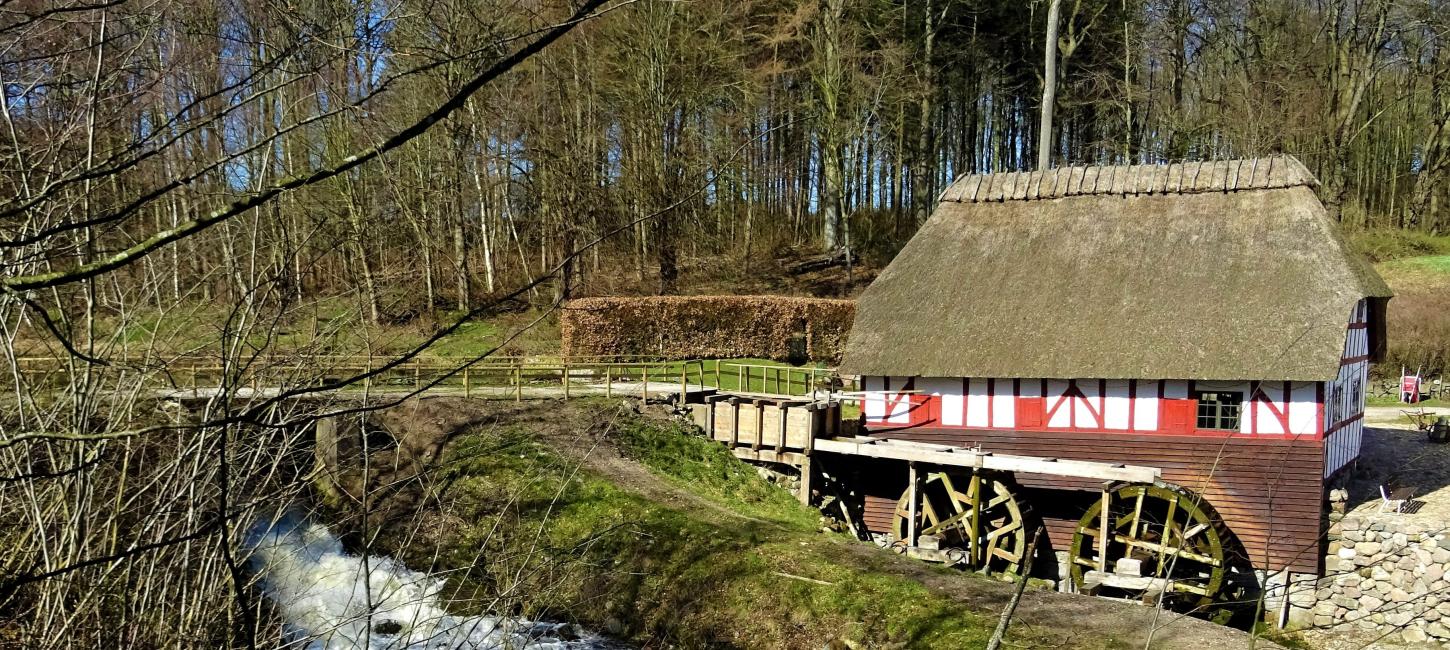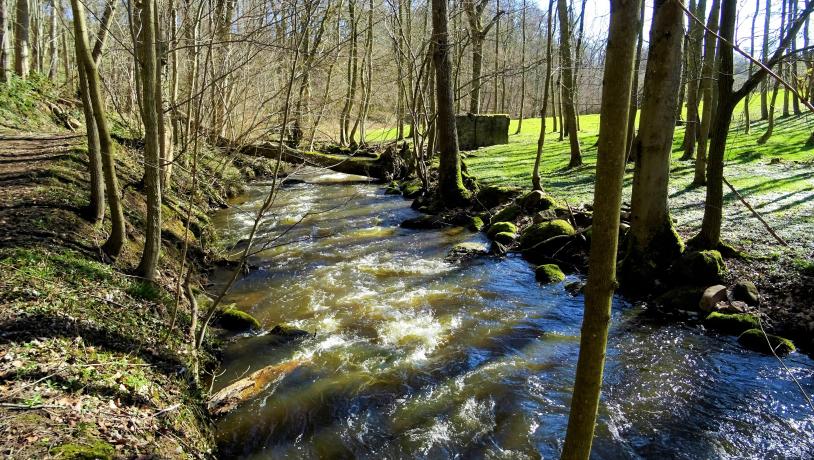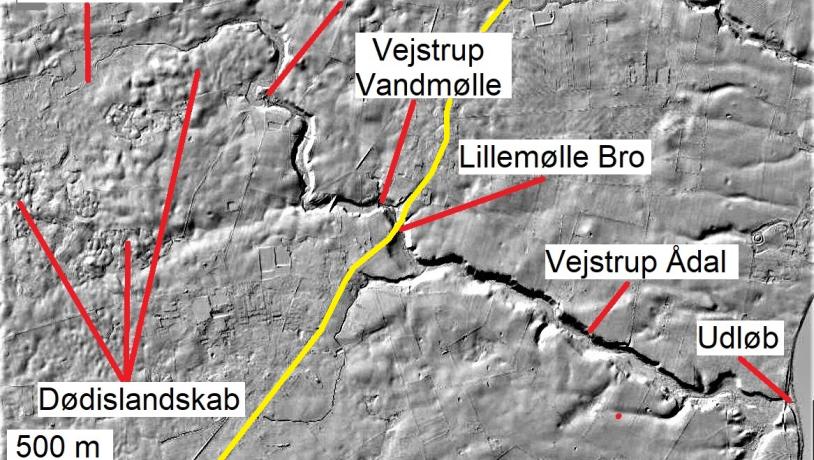
Vejstrup Ådal (Vejstrup Stream Valley)
Beautiful stream valley with an old watermill, springs, interesting geology and archaeology and a lovely walk through varied and species-rich forest.
Vejstrup Ådal is located 8 km east-northeast of Svendborg and is one of the most beautiful stream valleys on East Funen with its picturesque watermill, species-rich forest and steep valley sides. In some places, the vegetation gives it an almost jungle-like atmosphere. The catchment area of Vejstrup Å (Vejstrup stream) covers more than 40 km2 and the stream itself is around 17 km long.
The area is easily accessible from the parking lot at Lillemølle Bro (Lillemølle Brigde), where the road between Svendborg and Nyborg crosses Vejstrup Å. An approximately 4 km long stretch of the Øhavsstien hiking trail follows the stream - although not all the way to the outlet into the Great Belt. The watermill can only be viewed from the outside.
In the winter months and during periods of heavy rainfall, the path in the stream valley is often slippery and muddy, so appropriate footwear is recommended. But this is also where the watercourse really comes into its own and takes you back to a time when a rushing stream of meltwater flowed through the valley.
In the 1970s and 80s, a certain type of primitive flint flakes were found in the stream valley that made archaeologists wonder if we here had traces of some of the first humans in Denmark - or at least on Funen. However, partly because the flints were found as loose pieces in the stream and not in geological layers of known age, there is still great uncertainty about how old the finds actually are.

Photo:Søren Skibsted
The ice age landscape around Vejstrup Ådal
To the west, Vejstrup Ådal begins in a high-lying, hilly dead ice landscape, while to the east it cuts into a moraine surface that slopes towards the Great Belt. The geological history of the stream valley is not yet fully understood and there have been different views of its formation over time. Perhaps the valley was originally created as a tunnel valley under the ice by meltwater flowing westward. The water came from the part of the Bælthav Ice Stream known as the 'Great Belt Glacier' (18-17,000 years before present).
After the glacier melted back, the stream valley apparently drained meltwater from large immobile ice masses (dead ice) that had been left in the terrain around the Højes Dong hills further west. The meltwater now flowed eastwards towards the Great Belt lowland and cut further into the moraine surface around the towns of Vejstrup and Øster Åby. This gave the stream valley its current shape.
Between Højes Dong Hills and Klingstrup, Vejstrup Å passes the low-lying areas of Sortemose (Black Bog) and Lundemose (Lunde Bog). These were originally dead-ice filled depressions that were filled with lake and bog deposits after the end of the last ice age 11,700 years ago.
Parts of the 15-25 m deep stream valley still retain the V-shaped cross-section that is characteristic of many valleys formed by flowing water - although the ravages of time have smoothed out some of the landforms. The streambed is characterized by many stones, some of which originate from earlier reinforcements of the banks of the stream.
The geological conditions and limestone-rich glacial deposits in and around the stream valley give rise to many springs. Notice how the lime is separated by the bubbling water and encapsulates leaves, twigs, branches and pebbles with crusts of spring lime. In one place in the valley, up to 1.5 m thick layers of spring limestone have formed since the Ice Age, which were dug up in the 1800s and used for agricultural marling.

Photo:Kort: GeoFyn. Illustration: Søren Skibsted.
Hydropower and mill operations
The stream of Vejstrup originates at an altitude of approximately 75 meters at the foot of the Højes Dong hills. From Vejstrup to the outlet into the Great Belt, the stream has a drop of more than 30 m over a stretch of 4.2 km. Hydropower was harnessed in several places, including Vejstrupgård, where the current watermill was built in 1838. However, watermills have existed on the site since the 1500s. The mill was originally a grain mill, and in addition to milling, grain and animal feed were traded. Next door to the watermill was a Dutch windmill from 1850 to 1922.
The mill building is constructed of oak timberwork with a half-hipped, thatched roof. The watermill itself is a so-called waterfall mill with a mill pond and wooden slides that carry the water over the two large water wheels, where the weight and force of the falling water drives the wheels around.
Vejstrup Watermill continued to operate until 1975. It was listed in 1959 and is now privately owned. For a number of years, it has served as a museum mill. One of the water wheels drives a generator that supplies electricity to the miller's house north of the watermill.
The landscape in the future
From a geological perspective, the glacial landscape in and around Vejstrup Ådal is unlikely to change in the foreseeable future. Increased precipitation will generally affect the groundwater level and runoff conditions on the surrounding moraine surface and locally raise the water level in local depressions, which is detrimental to cultivation areas with low-lying soils and low-lying properties. The marsh and wetland areas in the catchment area of the watercourse will also be affected.
Large parts of the moraine landscape are covered with vegetation and/or cultivated, which, together with the clay surface layers and moderate terrain slopes, is unlikely to lead to significant changes in surface erosion, even with an increasing frequency of cloudbursts.
A general increase in precipitation coupled with the expectation of future episodes of high precipitation intensity will have an impact on the flow pattern in Vejstrup Å, and the erosion rate of the banks along exposed locations along the lower course of the watercourse will increase. It will also lead to changes in the amount of sediments and organic material carried by the stream, and an increased leaching of nutrients from cultivated areas in the catchment area is to be expected. As a result, the coastal areas around the stream's outlet into the Great Belt may experience increased loads of unwanted nutrients.
The expected future sea level rise will only affect the most coastal parts of the watercourse, where even a one meter rise in water level will probably only affect a stretch of just over 100 m upstream from the outlet. In an extreme situation with a 3.5 m rise in water level in connection with a rare storm surge of this magnitude, the sea could penetrate approximately 1 km up the stream.
Value
Vejstrup Ådal is one of the most beautiful and interesting stream valleys on East Funen. With a geological history that has not yet been fully investigated and archaeological finds of uncertain but apparently considerable age, the site invites future geological as well as archaeological investigations. The stream valley is also of cultural-historical, botanical and recreational value. Parts of the stream valley are §3-protected due to the presence of different habitats.
Vejstrup Mill is an important part of the cultural heritage as it is well-preserved and fully functional. It is a typical example of an eastern Danish mill with a mill pond, mill race and free run, which is braced by stone walls. It is representative of water mills with double overshot wheels from the early 19th century.
Longitude: 10.707824
Latitude: 55.100266